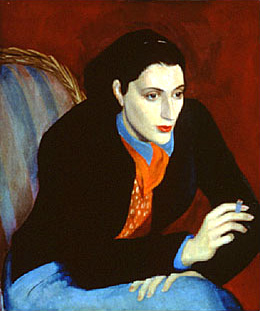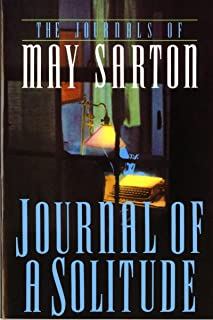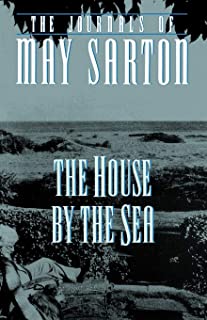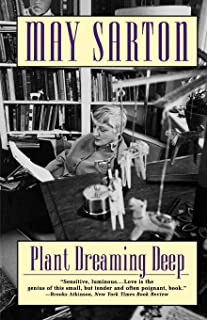- Read
- On The Writer
- On The Writing
- Favorite Quotes
- Photos
- Film and Audio
- Bibliography
- News
- Order Books
Treasure on the Wind: A Tribute To May Sarton by Rev. Barbara Carlson
May SartonMay 3, 1912 - July 16, 1995
If you were here last Sunday you heard a group of young people share some of their experiences at the General Assembly of the Unitarian Universalist Association in Spokane this past summer. Each year in June UUs from all over the continent gather to worship, play, dance, sing and do the business of the organization. (This will happen in Indianapolis in June 1996). The Ware lecture given by a prominent person is a regular event at General Assembly. This past year it was given by Norman Lear, the television producer and founder of "The American Way."
In the early 80's when the General Assembly met in Maine, May Sarton was invited to give the Ware lecture. Recalling that event in her Journal, she said the best moment was when, after reading "Dialogue" "a wave of laughter from 2000 people really raised the roof." (ASAJ, 81)
Here is the poem that made 2000 Unitarian Universalists laugh:
Dialogue (CP30-93, 167)
The teacher of logic said, "Reason."
The poet said, "Passion."
"Without logic, we muddle
And fail," said the teacher
Of reason.
The poet said, "Fiddle!
What about Nature?"
"Has Nature no plan,
You poor fuddled creature?
You're a rational man,
Not an ape or an angel."
The poet said, "Nonsense!
I'm an angel, an ape,
And a creature of sense,
Not a brain in a box
That a mere jackanapes
With logic unlocks.
I'm total. I'm human.
It's you who are not."
"You sound like a woman."
The poet said, "Rot!
You're just a machine.
You can't write a poem.
You can't make a dream."
But the logical man
Said, "I'll stick to my reason."
(He said it with passion.)
Remembering that occasion, Sarton said,
The President introduced me as 'our poet,' which was a beautiful beginning. I feel that the Unitarian Universalists are a community I can happily feel at home with. In that huge gymnasium there was so much intelligence and concern, such good, open, caring faces, so many men and women I longed to know. I am proud to be called their poet. (ASAJ, 81)
*******
Eleanore Marie Sarton was born in Belgium. She came with her parents to this country in 1916 after emigrating first to England following the outbreak of World War I. Her father was a historian of science. Her mother was an artist and designer who passed a well worn copy of Whitman's "Leaves of Grass" and her love of poetry on to her daughter. Some of Sarton's most touching work was written to her parents. Nor did the complexities of family life escape her notice. In one of her novels a character said,
Family life! The United Nations is child's play compared to the tugs and splits and need to understand and forgive in any family .... like every hard truth, we all try to pretend it isn't true. (KOL, 39)
Here is a poem entitled "August Third" which Sarton wrote as she, herself, was approaching 80:
August Third (CP30-93, 501)
These days
Lifting myself up
Like a heavy weight,
Old camel getting to her knees,
I think of my mother
And the inexhaustible flame
That kept her alive
Until she died.
She knew all about fatigue
And how one pushes it aside
For staking up the lilies
Early in the morning,
The way one pushes it aside
For a friend in need,
For a hungry cat.
Mother, be with me.
Today on your birthday
I am older than you were
When you died
Thirty-five years ago.
Thinking of you
The old camel gets to her knees,
Stands up,
Moves forward slowly
Into the new day.
If you taught me one thing
It was never to fail life.
My experience in working with families to prepare a service of memory is that in listening to the life of a person and what really mattered, I often hear a telling phrase or a theme that, as in a symphony, gains richness and variety as it emerges and re-emerges over the person's lifetime. I think the themes—and there were several—that were essence in May Sarton's life are expressed in words she often used as the theme for her poetry readings. She said, "The delights of the poet as I jotted them down turned out to be light, solitude, the natural world, love, time, creation itself." (quoted in FMSW, 2) May Sarton said she wanted to be remembered most for being "fully human."
So let us pay tribute to a fully human woman who lived a life of stunning integrity and unflinching honesty.
Let us pay tribute to a poet who sacramentalized the ordinary and the everyday as well as the amazing miraculous beauty she saw around her in flowers and animals and sea and sky and trees and all things natural.
Let us pay tribute to an artist with a deep sense of social conscience as well as individual integrity, a person who never ceased to explore the depths of her own unique vision of life.
And as we honor the life and art of May Sarton, let us ask ourselves: What can we learn from her vision of life that will help us live our own vision more fully?
Sarton said, "So I am just hoping that when it is all added up, what will come through is a vision of life. And what does one mean when one says that? It is simply that every human being sees life for himself, if he's honest, in a way that no one else sees it." She reflected that "Of course one is different selves for different people, but deep down inside to oneself, one is always somewhere it seems to me the same." (ATUD, 214) She thought that finding this "buried real self," the bedrock underlying roles and expectations and varying outer circumstances, may be what life is about.
Paradoxically, Sarton also understands this buried real self to be the matrix, the source where we connect with the universal. In a letter to a friend she wrote,
I don't know exactly what is meant by the inner current, but I think the writing of a poem presupposes at least a temporary solution of conflict... so it must be the touching of humanity in oneself, the place where one is universal just because one has gone down deep enough into oneself, and I suppose that might be the current for a poet; [her] humanness. (ATUD 223)
With typical honesty, she added: "It is the opposite of negative brooding of which I do far too much." (Ibid.) This transparency about her own faults and foibles is an endearing trait in May Sarton's journals. Her tendency to brood; her difficulties in dealing with the demon "anger"; her over-sensitivity to criticism, and the on-going, ambivalent tension she experienced between her desire for solitude and her desire to truly connect with others are all expressed and explored. She didn't gloss over her "shadow self" as the Jungians would call it. Her own negative traits were part of the self that she mined deeply. It is said that the closer we get to the treasure, the more fierce and hideous the monsters guarding it become. Sarton looked them in the eye and did not turn back in her soul journey.
*******
In remembering this woman who wanted to be remembered most for being "fully human" I want to lift up four "human" themes that I find recurring in her life and work:
- her deep love for the natural world;
- her reflections on creativity, and the creative process;
- her thoughts on identity and sexuality and the centrality of love and human relationships, and, finally,
- her life philosophy and some observations on aging.
To begin—
Sarton's ability to celebrate the beauty of the natural world is lyrical in "The Snow Light."
The Snow Light (FMSW, 16)
In the snow light,
In the swan light,
In the white-on-white light
Of a winter storm,
My delight and your delight
Kept each other warm.
The next afternoon
And love gone so soon!—
I met myself alone
In a windless calm,
Silenced at the bone
After the white storm.
What more was to come?
Out from the cocoon,
In the silent room,
Pouring out white light,
Amaryllis bloom
Opened in the night.
The cool petals shone
Like some winter moon
Or shadow of a swan,
Echoing the light
After you were gone
Of our white-on-white.
She adored animals. In her later years she lived on the Maine coast with her dog, Tamas, and her cats, Bramble and Perriot. In her Journal of the Eightieth Year, Sarton wrote of getting up in the night, often more than once to let the unpredictable Perriot in or out of the house at 1 or 4 a.m., even when she was quite desperately sick. Some years earlier in a letter to a friend she wrote:
I feel that everything is or can be illuminated by the same Creative Presence if one sees it there—even a stone. In some profound way I feel that animals are one of our ways back to the primitive in the sense of being close to God. Also, in the sense of being 'natural' as we in our complexities, are no longer. So I believe they help us to be more fully human... as 'creaturely' as possible (to MH 4 mar 70 in ATUD, p. 119)
One of the "fan" letters Sarton treasured most was from an eight year old boy who said that The Fur Person was the best book he ever read. The Fur Person chronicles the life of the fabulous cat, Tom Jones, who lived with May Sarton and her companion, Judy Matlack, for many years. Here is a sample from an 8 year old's favorite:
I'm a whiffling wonder
And my purr's like thunder,
I'm an elegant fellow
And my temper's mellow
And my eyes as green
As have ever been seen;
I've a coat like silk,
Paws white as milk,
I'm a catly cat,
An aristocrat
If you wish to see
Tom Jones, I'm he.
This Jones victorious
Glossy and glorious
Lordly and lazy
And catnip crazy
Yes, glorious Jones
Is me!
(from The Fur Person, pp. 79-80)
In addition to The Fur Person May Sarton wrote 17 more novels and 14 books of poetry, as well as her journals and other works of non-fiction.
In her younger years she experienced some conflict between what she felt was her obligation to write well and "to be as good a human being as possible." She was troubled by whether she could justify such selfish work as writing and wondered if she "ought not be somewhere in a slum teaching deprived children." In her later years she took comfort in her work's having been "useful" whether or not it lasted. (ASAJ, 271-272)
She said,
What kept me going was, I think, that writing for me is a way of understanding what is happening to me, of thinking hard things out. I have never written a book that was not born out of a question I needed to answer for myself. Perhaps it is the need to remake order out of chaos over and over again. For art is order, but it is made out of the chaos of life. (Ibid., 105)
On writing poems she said,
I was interested to see that Matisse begins with a literal rendering of an object or person then gradually reduces it to its essence, drawing by drawing. That is the way I write poems. (to BB, Jan 47; ATUD 222)
When my poems are good, which is very rarely! it is because they are each time an act of the spirit.
A poem comes at a moment when thought and emotions are fused at a high pitch of intensity—and are married in an image. (to BB Oct 49; Ibid., 224)
The trouble is one does not choose what one is to write about: poetry is a seizure and not done on will. (to KD, Apr 64; Ibid., 225)
May Sarton's "seizures" were surely inspired yet she never shirked the discipline of her art. She said:
When I am really inspired I can put a poem through a hundred drafts and keep my excitement. But this sustained battle is possible only when I am in a state of grace, when the deep channels are open, and when they are, when I am both profoundly stirred and balanced, then poetry comes as a gift from powers beyond my will. (FMSW, 136)
In later years she observed that "the inner world, the world of poetry is as much nourished by the bad times as by anything." (Ibid.)
*******
I turn now to themes of identity, and the centrality of love.
May Sarton believed the artist is androgynous. She said, "It is the masculine in a woman and the feminine in a man that proves creative. This I have always believed." (Ibid., 127)
When she was asked to review a book called "I Thought People Like That Killed Themselves—Lesbians, Gay Men and Suicide" by Eric E. Rofes, Sarton wrote that it was
a very good book, a very sad one, sad because in so many of the instances of suicide he relates, the reason is fear of exposure, either to parents, to the job milieu, or to society in general. The anxiety, self doubt and trauma almost every homosexual carries is hard to imagine, even now when things are so much more open that they were when I was young. I realize more and more that my own position has been privileged because I have no immediate family and no 'job' is at risk. That gives me a great responsibility to be open and talk about this matter ....The more the homosexual is isolated and driven into ghettos, the less whole and at ease he [or she] must feel. I want to make bridges... (ASAJ, 235-236)
She admired Eric Rofes' courage in writing and saluted his book.
Then she noted that
It would be interesting at this juncture if someone would write a book about homosexual marriages, making clear that there are a great many happy and viable ones all around us." (Ibid.)
The general public hears only the bad news, she regretted. "It is as if all we knew about heterosexual society was wife beating, plural divorces, molestation of children by their parents, incest, alcoholism, and nothing else." (Ibid.)
May Sarton believed that sexual preferences are biologically based and inborn. She came out as a lesbian in 1965. Yet she always saw her creative work as universal. In a letter to her friend Louise Bogan, the poet and literary critic, written in 1954, Sarton said, "I do not wish to be known as a queer person until I am firmly established for central reasons, not a periphery person..." She mentioned a mutual friend whose life she felt had been wrecked because people knew too much about her private life and added, "They could no longer see her as she really is. Instead of being true in its effect, or an effect of truth, it just makes people unable to hear what you have to say." (Ibid., 102)
May Sarton said that her own love affairs had never been light, but had been "wholly committed." "They have been spiritual rather than physical adventures, in essence, and by them I have grown." (Ibid.)
The love of her life was Judy Matlack with whom she shared a home in Cambridge for many years. Sarton said, "There have been other great loves in my life but only Judy gave me a home and made me know what home can be." (ASAJ, 213)
Tragically, Judy suffered Alzheimer's disease and eventually did not recognize May. When word of Judy Matlack's death came Sarton wrote "Mourning to Do."
Judy is dead. Judy is gone forever.
I cannot fathom the darkness, nor know
Whether the true spirit is alive again.
But what I do know is the peace of it,
And in the darkened room before dawn, I lie
Awake and let the good tears flow at last...
(excerpted. FMSW, p. 91)
*******
Finally, May Sarton's life philosophy and her thoughts on aging. Sarton's Journals reveal a keen sense of social justice and awareness of the pain in living. She had great admiration for Martin Luther King, observing that it wasn't soft idealism that got "a whole city of Blacks to walk to work for a year to desegregate buses as he did in Montgomery." She saw love as "action." She said that the one commandment of Christ she could truly understand is "What ye have done unto the least of these ye have done unto me." (to MH June 70; ATUD)
In her Journal of the 80th year she wrote of her anger regarding the Gulf War which she regarded as an outrageous and unnecesssary war that brought untold grievous suffering to many innocents, especially children.
Her sensitivity to pain and suffering in the world did not blind her to life's pleasures. She said,
Many people have taken the attitude that they must bear the world's pain and never be happy (a typically Puritan idea) while I feel it is a betrayal of life and a sin not to appreciate doubly all there is of joy and of luck in our lives here. It will not be for long. (Ibid. 211)
May Sarton was a member of the Unitarian Universalist Church of Portsmouth, NH. She observed that "for us who have no religion in the old-fashioned sense ...nature itself—nature and human love—polarize, and we pray by being fully aware of them both." (FMSW, 45)
She believed people can love powerfully and passionately at all ages. In the last decades of her life May Sarton suffered cancer, strokes and other illnesses yet she held on to her love of life. She said,
The more our bodies fail us, the more naked and more demanding is the spirit, the more open and loving we can become if we are not afraid of what we are and what we feel. (Ibid., 100)
Here is an excerpt from "Gestalt at Sixty":
Just as the fruit gathers
All the riches of summer
Into its compact world,
I feel richer than ever before,
And breathe a larger air.
I am not ready to die,
But am learning to trust death
As I have trusted life.
I am moving
Toward a new freedom
Born of detachment,
And a sweeter grace—
Learning to let go ....
(excerpt, Ibid., 40-41)
May Sarton wrote what I believe to be her best epitaph in these words:
I would like to believe that when I die that I have given myself away like a tree that sows seed every spring and never counts the loss, because it is not loss, it is adding to future life. It is the tree's way of being. Strongly rooted, perhaps, but spilling out its treasure on the wind. (Ibid., 130)
For this woman who so gloriously spilled out her treaure on the wind ...all praise, all honor "as for the trees on hot summer days."
Unitarian Universalist Nothern Hills Fellowship, November 5, 1995
SOURCES
May Sarton, Among the Usual Days, A Portrait. Unpublished poems, letters, journals and photographs. Selected and edited by Susan Sherman. (New York: W.W. Norton & Co., 1993). CODE: ATUD.
Sarton, May. At Seventy, A Journal. (New York: W.W. Norton & Co., 1984). CODE: ASAJ.
-----. Collected Poems, 1930-1993. (New York: W.W. Norton & Co., 1993). CODE: CP30-93.
-----. Encore, A Journal of the Eightieth Year. (New York: W. W. Norton & Co., 1993). CODE: EJOEY.
-----. From May Sarton's Well, Writings of May Sarton. Selections and Photographs by Edith Royce Schade. (Watsonville, CA: Papier-Mache Press, 1994). CODE: FMSW.
-----. Kinds of Love. (New York. W.W. Norton & Co., 1970). CODE: KOL.
-----. The Fur Person. (New York: W.W. Norton & Co., 1983, paperback). CODE: TFP.
Source: https://www.uunhf.org/sunday/sermons/text/19951105/





